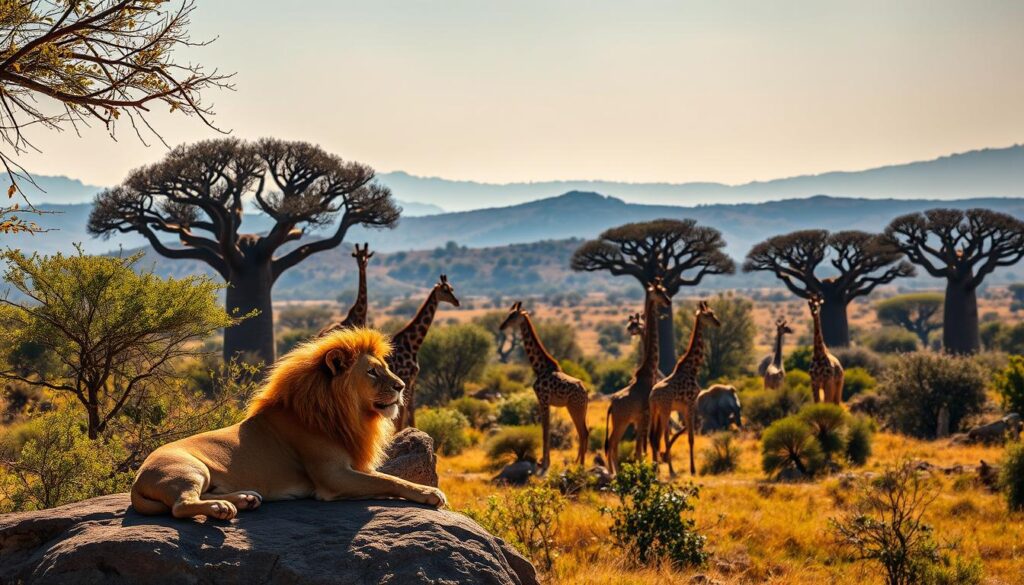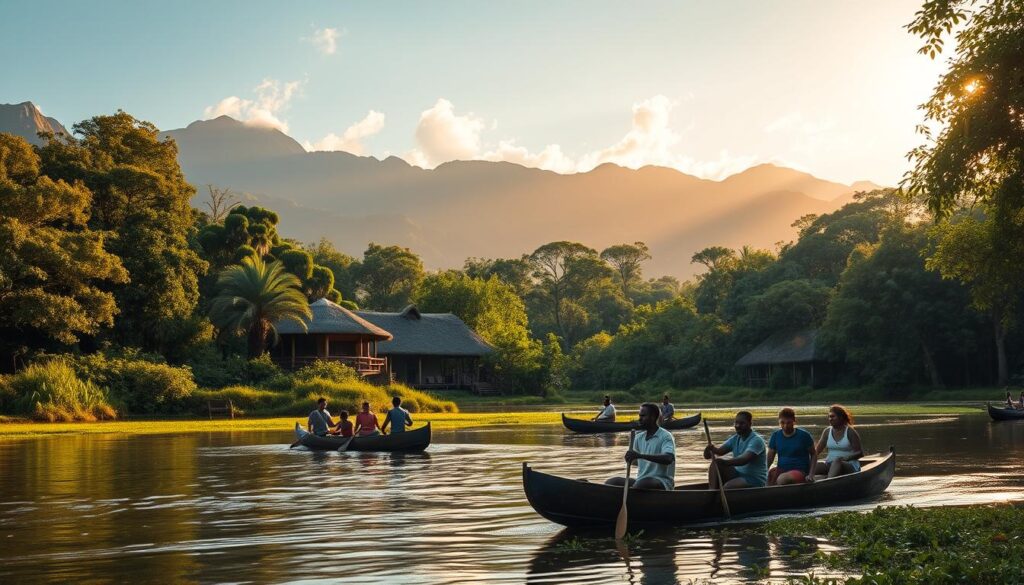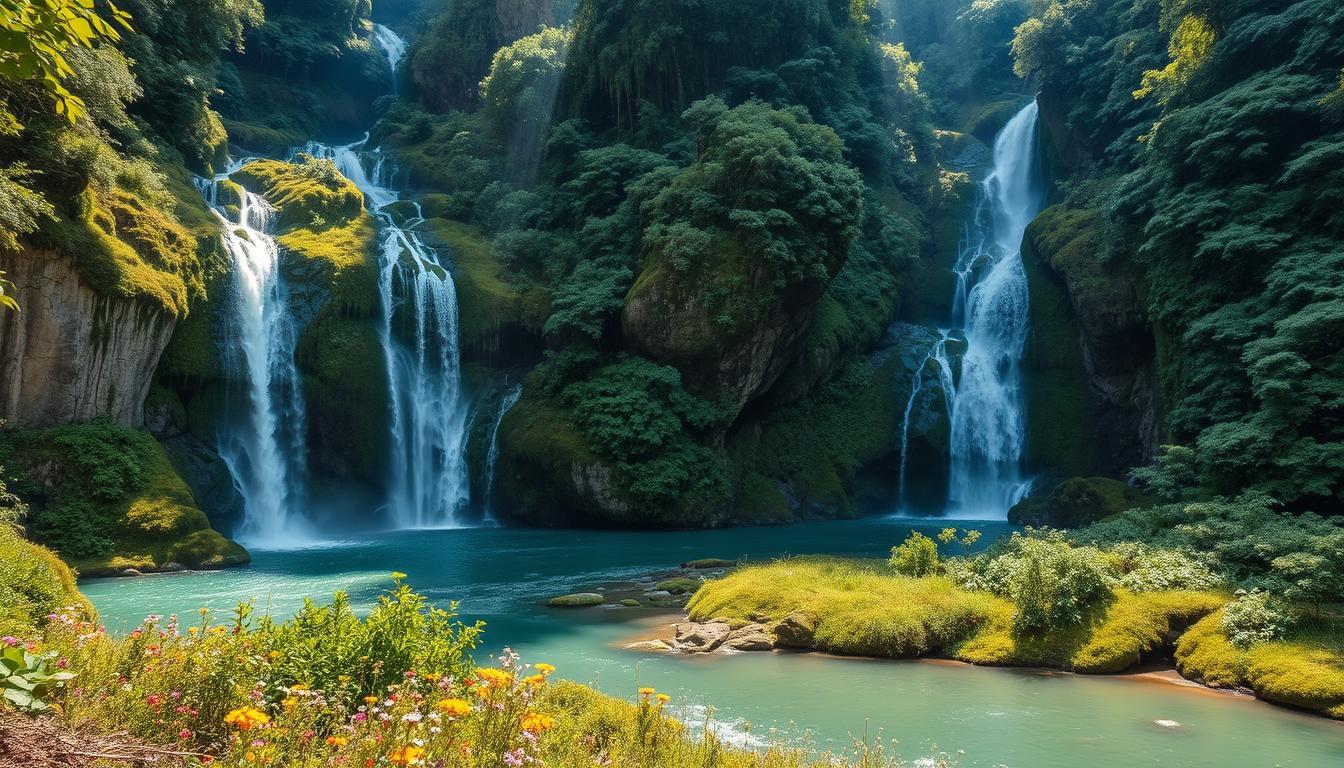Imagine finding a place where nature’s beauty is untouched. This hidden gem in Africa is waiting for adventurers. Here, you’ll see landscapes untouched by most tourists.
This African treasure offers a unique experience of untouched wilderness. From rugged coasts to vast savannahs, it invites you to explore. It’s a chance to see a true cultural and geographical landscape that few have seen.
Get ready to be amazed by the diverse nature, wildlife, and traditions here. Your journey will mix old traditions with modern sights. It’s a travel experience that breaks the mold of what you think of Africa.
Table of Contents
Discovering the Unique Geography of Angola
This area is a treasure trove of natural wonders. It has a diverse landscape that amazes adventurous travelers. From sweeping savannahs to dramatic coastlines, it offers breathtaking views. These landscapes are untouched by most tourists.
The geography of this region is stunning. It attracts explorers and nature lovers. Let’s explore the terrains that make it a hidden gem of natural beauty.
Vast Savannahs and Plateaus
Angola’s interior has vast savannahs that stretch endlessly. These grasslands are known for:
- Rolling plains with scattered acacia trees
- Rich biodiversity supporting unique wildlife
- Elevation ranges from 1,000 to 2,000 meters above sea level
“The savannahs of Angola are not just landscapes, they are living, breathing ecosystems waiting to be discovered.” – Wildlife Conservation Expert
Coastal Beauty and Fisheries
The Atlantic coastline is stunning. It has golden beaches and vibrant marine ecosystems. Places like Ilha do Mussulo have crystal-clear waters and spectacular views, untouched by mass tourism.
The Majestic Kalahari Desert
This desert stretches into the southeastern regions. This semi-arid landscape has unique geological formations. It also supports remarkable adaptations of flora and fauna.
Each geographical zone makes Angola a destination of extraordinary natural wonders. It invites travelers to explore its raw and unspoiled beauty.
Each geographical zone makes this area a destination of extraordinary natural wonders. It invites travelers to explore its raw and unspoiled beauty.
This wilderness is a top spot for wildlife lovers. The national parks are home to many unique and rare species. These parks attract nature enthusiasts from all over the world.

The Giant Sable Antelope is a symbol of this region’s wildlife. Critically endangered and found only in this area, they are a success story in conservation. Quicama National Park is a key place for these animals, helping to save them from extinction.
The Giant Sable Antelope is a symbol of Angola’s wildlife. Critically endangered and found only in this region, they are a success story in conservation. Quicama National Park is a key place for these animals, helping to save them from extinction.
- Unique to Angola’s landscapes
- Considered a national symbol
- Population slowly recovering through conservation efforts
Bird Watching Paradise
Iona National Park is a bird watcher’s dream. Its varied landscapes draw many bird species. It’s a top spot for bird lovers and photographers.
“Angola’s skies are alive with the wings of incredible bird species waiting to be discovered.” – Wildlife Conservation Expert
Endangered Species and Conservation
Protecting wildlife in the parks is vital. Quicama and Iona National Parks are key in saving endangered species. They help keep the ecosystem balanced.
- Protecting habitat zones
- Monitoring wildlife populations
- Supporting research and preservation
Your trip to Angola will be unforgettable. You’ll see some of the world’s most amazing wildlife.
Cultural Tapestry of Angola
This country has a rich cultural mix. It combines different ethnic traditions, colonial influences, and lively celebrations. Your trip through the Footsteps of a Warrior Queen shows a complex and interesting cultural mosaic. This mosaic is what makes this area a unique African nation.
Ethnic Diversity and Traditions
This culture is made up of many ethnic groups. Each group brings its own traditions and customs. Some of the main ethnic communities are:
- Ovimbundu: Largest ethnic group, known for intricate textile arts
- Mbundu: Central region inhabitants with rich musical heritage
- Bakongo: Northern tribes with sophisticated wood carving skills
Influences of Colonial History
Colonial history has greatly influenced the culture here. You can see this in language, architecture, and social practices. Luanda, the capital, is a clear example of this complex history.
“Culture is the soul of a nation, and in Angola, that soul speaks multiple languages and tells countless stories.” – Cultural Historian
Festivals show the nation’s lively spirit and cultural strength. Here are some amazing celebrations to experience:
Angolan festivals show the nation’s lively spirit and cultural strength. Here are some amazing celebrations to experience:
| Festival | Month | Significance |
|---|---|---|
| Carnival of Luanda | February | Colorful street parades celebrating national unity |
| Independence Day | November | Commemorating Angola’s liberation |
| Traditional Dance Festival | July | Showcasing indigenous dance forms |
Every celebration in Angola tells a story of strength, creativity, and pride. Exploring this country will uncover layers of tradition that shape its identity.
Breathtaking Landscapes Worth Visiting
These natural wonders are a call to adventure. The landscapes are so amazing, they seem from another world. From moon-like terrains to untouched coastlines, there’s a feast for the eyes. Your trip through this region will be filled with unforgettable moments in some of the world’s most stunning natural spots.

The Enigmatic Namib Desert
The Namib Desert is a stunning sight along the west coast. Its rocky ground and few plants make it look like another planet. Visitors can see incredible rock shapes and feel the deep quiet of this unique place.
- Extreme temperatures ranging from 0°C to 60°C
- Unique wildlife adaptation strategies
- Stunning geological formations
Luanda’s Scenic Waterfront
Luanda to the Moon is a mix of old and new, with beautiful views. The waterfront shows off Angola’s lively spirit. You can watch sunsets, visit markets, and feel the city’s energy.
The Impressive Kwanza River
Cabo Ledo and the river show off the region’s natural variety. The river flows through green areas, perfect for fishing and seeing wildlife. It’s home to many species and helps local communities.
| Location | Key Features | Tourism Potential |
|---|---|---|
| Miradouro da Lua | Lunar-like landscape | Photography, Hiking |
| Cabo Ledo | Coastal scenery | Surfing, Beach Activities |
| Kwanza River | Diverse Ecosystem | Wildlife Observation |
These spots are just a taste of the beauty here. Whether you love adventure or nature, this region has something for everyone. It promises unforgettable experiences that will make you want to see more.
Adventurous Activities in Angola
This location is a thrilling place for adventure seekers. It has rugged landscapes and beautiful coastlines. Here, you can find real adventure travel experiences.
Exploring this wilderness is both challenging and inspiring. You’ll find many activities that show off the area’s natural beauty. These experiences are different from regular tourist activities.
Hiking in Serra da Leba
Serra da Leba is a top spot for hiking. It has tough terrain and amazing views. There are trails for all skill levels, so you can:
- Navigate steep mountain passes
- Explore unique geological formations
- Capture stunning landscape photographs
- Experience local mountain ecosystem
Surfing Along the Atlantic Coast
Cabo Ledo is a great place for surfing. It has big waves for all surfers. The Atlantic coast has perfect conditions with big swells and clean beaches.
Exploring the Caves of Lunda
The caves here are an underground adventure. They are full of natural wonders and might have ancient secrets. You can see cool rock formations and learn about the area’s past.
Angola offers many exciting activities for adventure lovers. You can find thrilling experiences that will push you to explore more.
Culinary Delights: What to Taste in Angola
The food scene is a colorful mix of tastes. It shows off the country’s rich culture. Your taste buds will go on an amazing trip through a mix of African, Portuguese, and local flavors.
Get ready for a food adventure. You’ll try some of Angola’s most unique and tasty dishes.
Get ready for a food adventure. You’ll try some of the most unique and tasty dishes from this area.
Cooking from this region is full of passion and creativity. You’ll find dishes that show off local cooking skills:
- Moamba de Galinha: A rich chicken stew that captures the essence of Angola’s cooking
- Calulu: A seafood delicacy featuring dried fish and spinach
- Fungi: A unique cornmeal-based dish that’s a staple in many Angolan homes
The Influence of Portuguese Cuisine
Portuguese history has shaped Angola’s food. You’ll see European cooking methods mixed with local ingredients. Try dishes like bacalhau (salted cod) and seafood for this blend.
The history has shaped the food. You’ll see European cooking methods mixed with local ingredients. Try dishes like bacalhau (salted cod) and seafood for this blend.
For the bold food lover, street food here is a must-try. Look for:
- Grilled meat skewers
- Pastéis (savory pastries)
- Fresh tropical fruit stands
Your food journey will be a fun trip of tastes and traditions. You’ll want more.
Historical Landmarks to Explore
This area is full of historical wonders waiting to be discovered. You can explore ancient rock art and colonial fortresses. These landmarks share stories of the past, showing the impact of different cultures.
Visiting these sites is like traveling back in time. You’ll see how the history is both deep and complex. Each place offers a special view into the past, highlighting its cultural strength and importance.
The Fortress of São Miguel: A Colonial Legacy
In Luanda, the Fortress of São Miguel shows the colonial past. Built in the 16th century, it’s a key example of:
- Portuguese architecture
- Its military role
- Angola’s complex history
Ancient Rock Art in Tchitundo-Hulu
Tchitundo-Hulu in Namibe Province is a must-see for history buffs. It has ancient rock art that’s thousands of years old. Here, you can:
- See detailed prehistoric drawings
- Discover archaeological finds
- Learn about ancient cultures
The Historic Town of Mbanza-Kongo
This site is a must-see for history buffs. It has ancient rock art that’s thousands of years old. Here, you can:
- Remains of royal buildings
- Significance of traditional kingdoms
- Links to Angola’s pre-colonial era
These landmarks offer a chance to explore Angola’s rich history. You can follow in the footsteps of a Warrior Queen and learn about the nation’s cultural heritage.
This area is changing how it views tourism. It now focuses on protecting its natural wonders and landscapes. The country is a leader in conservation and responsible travel, with new ways to help the environment and local people.

The government is working hard to keep nature safe. It has teamed up with conservation groups. A big step was a 20-year deal with African Parks for two national parks. This shows commitment to wildlife.
Eco-lodges in the Wilderness
Travelers can now see untouched areas in eco-lodges. These lodges are built to be green and support local conservation. They offer:
- Sustainable infrastructure using local materials
- Minimal carbon footprint designs
- Direct support for local conservation efforts
- Immersive experiences in untouched landscapes
Community-Based Tourism Initiatives
Programs have started that help local people. These give jobs and keep culture and nature alive. They make sure tourists help local communities grow.
Supporting Wildlife Conservation
Efforts are underway to save endangered animals and their homes. Strategic partnerships with global groups help. They work on wildlife paths, track animals, and teach people why saving nature is key.
“Sustainable tourism is not just about protecting landscapes, but about creating meaningful connections between travelers, local communities, and nature.” – Conservation Expert
Planning Your Trip to Angola
Planning a trip here is key for a great adventure. This place is full of natural beauty and culture. You need to plan well to enjoy it fully.
For a memorable trip, know the important details. These can make your journey truly special.
Best Times to Visit Angola
Choosing the right time to visit is important. The weather changes throughout the year, affecting your trip:
- Dry Season (May to October): Ideal for wildlife viewing and outdoor activities
- Wet Season (November to April): Perfect for lush landscape photography
- Peak Tourist Season: June to September, with mild temperatures
Visa and Travel Requirements
Getting your documents ready is a big step for travel here. You must:
- Obtain a valid passport with at least six months remaining
- Secure a tourist visa before arrival
- Provide proof of yellow fever vaccination
- Carry comprehensive travel insurance
Travel Safety Tips
Stay safe while exploring beautiful areas. Here are some tips:
- Research current political situations
- Stay informed about local health conditions
- Carry emergency contact information
- Use reputable local guides for remote areas
Your Angola adventure awaits – with proper preparation, you’ll unlock an unforgettable travel experience.
Making the Most of Your Angolan Adventure
Planning an adventure in Angola needs careful thought and cultural insight. Your trip to this amazing place is more than just packing a bag. Knowing local customs and travel tips can make your journey unforgettable.
Local Guides and Tours
Choose guides who really know the area. They should speak many languages and have lots of experience. They’ll show you around Luanda and the wild, sharing secrets you won’t find in books.
Essential Travel Apps
Get your phone ready with travel apps before you go. Download maps, translation tools, and local guides. Apps like Maps.me and Google Translate are super helpful.
Cultural Etiquette to Observe
Respecting local customs is key in Angola. Learn some Portuguese, dress right, and be curious. This way, you’ll connect with locals and enjoy your trip even more.
FAQ
What are the best national parks to visit in Angola?
Is Angola safe for adventure travelers?
What is the best time of year to visit Angola?
What unique natural wonders can I explore in Angola?
What adventure activities are available in Angola?
What are some must-try traditional Angolan dishes?
Do I need a visa to visit Angola?
What wildlife can I expect to see in Angola?
How can I contribute to sustainable tourism in Angola?
What cultural experiences should I not miss in Angola?
Making the Most of Your Angolan Adventure
Local guides are your key to real experiences. Companies like Turismo de Angola offer expert tours. They know the best spots and keep you safe and informed.



o2a2qw
f04plt
**mind vault**
mind vault is a premium cognitive support formula created for adults 45+. It’s thoughtfully designed to help maintain clear thinking
https://t.me/s/Online_1_xbet/572
//t.me/s/official_1win_aviator](https://t.me/s/official_1win_aviator)
https://t.me/s/PlayCasino_1xbet
https://t.me/s/PlayCasino_1win
https://t.me/s/PlayCasino_1xbet
https://t.me/s/PlayCasino_1win
https://t.me/s/ofitsialniy_1win/33/Wrile
https://t.me/s/iw_1xbet
https://t.me/s/Official_beefcasino
https://t.me/s/ofitsialniy_1win
**breathe**
breathe is a plant-powered tincture crafted to promote lung performance and enhance your breathing quality.
https://t.me/Beefcasino_rus/14
https://t.me/Best_promocode_rus/1514
https://t.me/Best_promocode_rus/3250
https://t.me/s/Beefcasino_rus/57
https://t.me/ud_Leon/60
https://t.me/s/ud_Fresh/64
https://t.me/ud_Jet/56
https://t.me/ud_Casino_X/58
https://t.me/?ud_1Go/55
https://t.me/s/ud_Rox/62
https://t.me/ud_GGBet/45
https://t.me/ud_JoyCasino/51
https://t.me/ud_Rox/50
https://t.me/s/ud_CatCasino/46
https://t.me/s/ud_DragonMoney/54
https://t.me/s/ud_Kent/57
https://t.me/ud_Daddy/62
https://t.me/s/ud_Martin/44
https://t.me/s/ud_MostBet/50
https://t.me/ud_1xSlots/56
https://t.me/s/ud_Lex/44
https://t.me/s/Beefcasino_rus/59
https://t.me/s/ud_Martin/61
https://t.me/ud_Martin/49
https://t.me/ud_1xSlots/59
https://t.me/?ud_1Go/62
https://t.me/ud_Vulkan/51
https://t.me/ud_Pin_Up/59
https://t.me/ud_Martin/47
https://t.me/ud_Legzo/57
https://t.me/s/ud_Riobet/62
https://t.me/s/ud_Vodka/6
https://t.me/s/ud_JoyCasino/18
https://t.me/s/UD_lex
https://t.me/s/Ud_pIn_up
https://t.me/s/ud_JoycaSino
https://t.me/s/uD_CASinO_X
https://t.me/s/ud_poKERdoM
https://t.me/s/Ud_rIoBet
https://t.me/s/Official_mellstroy_casino
https://t.me/official_1win_aviator/75
https://t.me/s/uD_1XBET
https://t.me/s/UD_drIp
https://t.me/s/official_1win_aviator/79
https://t.me/s/ud_1Go
https://t.me/s/UD_iRWIn
https://t.me/s/uD_leoN
https://t.me/s/ud_1XsLOtS
https://t.me/s/tf_1win
https://t.me/s/tf_1win
https://t.me/s/kfo_1win
https://t.me/s/kta_1win
https://t.me/s/tf_1win
https://t.me/s/official_1win_aviator/299
https://t.me/s/UD_pokeRdOM
https://t.me/s/Ud_StarDa
https://t.me/s/uD_LEgzO
https://t.me/s/ud_PLAYfortunA
https://t.me/s/UD_BOoi
https://t.me/s/Ud_gAMa
https://t.me/s/UD_vULKAn
https://t.me/s/ud_gIZbo
https://t.me/s/UD_DADdy
https://t.me/s/ud_monro
https://t.me/s/ud_jeT
https://t.me/s/Ud_LEX
https://t.me/s/uD_StAkE
https://t.me/s/ke_1Win
https://t.me/s/ke_Pokerdom
https://t.me/s/ke_Fresh
https://t.me/s/ke_JoyCasino
https://t.me/official_1win_aviator/109
https://t.me/s/ke_Jet
https://t.me/s/ke_Starda
https://t.me/s/ke_Gama
https://t.me/s/ke_Vulkan
https://t.me/s/ke_MrBit
https://t.me/s/ke_Riobet
https://t.me/s/ke_Daddy
https://t.me/s/ke_Booi
https://t.me/s/ke_Monro
https://t.me/s/kef_Lex
https://t.me/s/ke_Drip
https://t.me/s/ke_Gizbo
https://t.me/s/ke_Pin_Up
https://t.me/s/ke_1xbet
https://t.me/s/kef_beef
https://t.me/s/ke_Irwin
https://t.me/s/ke_1Go
https://t.me/s/ke_Kometa
https://t.me/s/ke_DragonMoney
https://t.me/s/ke_CatCasino
https://t.me/s/ke_Leon
https://t.me/s/ke_Vodka
https://t.me/s/ke_GGBet
https://t.me/s/ke_Sol
https://t.me/s/ke_Pinco
https://t.me/s/ke_Casino_X
https://t.me/s/official_1win_aviator/574
https://t.me/s/ke_Martin
https://t.me/s/kef_Rox
https://t.me/s/official_1win_aviator/89
https://t.me/s/ke_mellstroy
https://t.me/s/ke_Legzo
https://t.me/s/ke_Stake
https://t.me/s/ke_1xSlots
https://t.me/s/ke_Volna
https://t.me/s/top_kazino_z
https://t.me/s/topcasino_v_rossii
https://t.me/s/a_Top_onlinecasino/10
https://t.me/a_Top_onlinecasino/7
https://t.me/s/a_Top_onlinecasino/6
https://t.me/s/a_Top_onlinecasino/5
https://t.me/s/a_Top_onlinecasino/17
https://t.me/s/a_Top_onlinecasino/2
https://t.me/a_Top_onlinecasino/21
https://t.me/s/a_Top_onlinecasino/13
https://t.me/topcasino_rus/
https://t.me/iGaming_live/4547
https://t.me/iGaming_live/4611
https://t.me/va_1xbet/13
https://t.me/s/va_1xbet/9
https://t.me/va_1xbet
https://t.me/s/va_1xbet/6
https://t.me/surgut_narashchivaniye_nogtey/19
https://t.me/surgut_narashchivaniye_nogtey/6
https://t.me/ah_1xbet/5
https://t.me/s/ah_1xbet/22
https://t.me/s/ah_1xbet/20
https://t.me/ah_1xbet/17
https://t.me/s/ah_1xbet/12
https://t.me/ah_1xbet/13
https://t.me/s/ah_1xbet/21
https://t.me/ah_1xbet/6
https://t.me/ah_1xbet/21
https://t.me/s/ah_1xbet/11
https://t.me/ah_1xbet/7
https://t.me/s/ah_1xbet/4
https://t.me/s/Best_rating_casino
https://t.me/s/reyting_topcazino/15
https://t.me/topcasino_rus/
https://t.me/a_Topcasino/4
https://t.me/top_ratingcasino/2
https://t.me/a_Topcasino/10
https://t.me/top_ratingcasino/6
https://t.me/a_Topcasino/8
https://t.me/a_Topcasino/2
https://t.me/top_ratingcasino/5
https://t.me/a_Topcasino/7
https://telegra.ph/Top-kazino-11-14-2
https://t.me/kazino_bez_filtrov
https://t.me/s/kazino_bez_filtrov
https://t.me/da_1xbet/8
https://t.me/da_1xbet/10
https://t.me/da_1xbet/4
https://t.me/da_1xbet/7
https://t.me/da_1xbet/6
https://t.me/da_1xbet/3
https://t.me/da_1xbet/9
https://t.me/da_1xbet/14
https://t.me/da_1xbet/11
https://t.me/rq_1xbet/1271
https://t.me/rq_1xbet/1244
https://t.me/rq_1xbet/1501
https://t.me/s/rq_1xbet/672
https://t.me/s/rq_1xbet/976
https://t.me/s/reyting_topcazino/22
https://t.me/s/rq_1xbet/1067
https://t.me/s/rq_1xbet/1426
https://t.me/s/Official_1xbet1/861
https://t.me/Official_1xbet1/986
https://t.me/s/Official_1xbet1/128
https://t.me/s/Official_1xbet1/132
https://t.me/s/Official_1xbet1/160
https://t.me/Official_1xbet1/660
https://t.me/Official_1xbet1/221
https://t.me/s/Topcasino_licenziya/29
https://t.me/Topcasino_licenziya/18
https://t.me/kazino_s_licenziei/4
https://t.me/s/Topcasino_licenziya/54
https://t.me/Topcasino_licenziya/23
https://t.me/kazino_s_licenziei/6
https://t.me/top_online_kazino/6
https://t.me/s/reyting_luchshikh_kazino
https://t.me/s/top_online_kazino/5
https://t.me/top_online_kazino/10
https://t.me/s/top_online_kazino/4
https://t.me/s/top_online_kazino/7
https://t.me/top_online_kazino/7
https://t.me/top_online_kazino/4
http://apnewstracker.com/__media__/js/netsoltrademark.php?d=https://t.me/Official_1xbet_1xbet/1723
http://lomprey.net/__media__/js/netsoltrademark.php?d=https://t.me/s/Official_1xbet_1xbet/1225
https://images.google.com.qa/url?sa=t&url=https://t.me/Official_1xbet_1xbet/1120
https://www.avito.ru/surgut/predlozheniya_uslug/apparatnyy_manikyur_i_pedikyur_s_pokrytiem_4030660549?utm_campaign=native&utm_medium=item_page_ios&utm_source=soc_sharing_seller
http://unitedwealthsolutions.com/__media__/js/netsoltrademark.php?d=https://t.me/s/Official_1xbet_1xbet/758
https://images.google.kz/url?sa=t&url=https://t.me/Official_1xbet_1xbet/1078
https://t.me/s/om_1xbet/5
https://t.me/s/om_1xbet/10
https://t.me/om_1xbet/11
https://t.me/s/om_1xbet/7
https://t.me/top_casino_rating_ru/7
https://t.me/s/om_1xbet/6
https://t.me/s/om_1xbet/15
https://t.me/top_casino_rating_ru/9
https://t.me/s/om_1xbet/4
1 вин экспрессы — быстрое и выгодное решение для любителей ставок! Делай ставки на спорт и в онлайн-казино с высокими коэффициентами, получай до 100% бонусов за депозит, фриспины и кэшбэк, а благодаря личному кабинету и мгновенным выплатам вывод выигрыша занимает секунды. Открывай личный кабинет, используй промокод и выигрывай с 1win уже сегодня!
1win power booster — активируй свои шансы на максимум! Получай до 500% бонуса за депозит, участвуя в лайв-ставках и слотах с высокими коэффициентами, соревнуйся за крупные призы и фриспины. Быстрый вывод выигрышей, кэшбэк до 15%, личный кабинет для удобства и круглосуточная поддержка — всё для реальных побед и непрерывного удовольствия на 1win!
Как выводить с 1win? Быстро оформляй вывод через личный кабинет — выгодные кэшбэки до 10%, бонусы за депозит и фриспины при регистрации, а также высокие коэффициенты на ставки на спорт и слоты. Минимальный вывод — всего 300 рублей, деньги поступают мгновенно, а круглосуточная служба поддержки всегда поможет!
https://t.me/s/ef_beef
https://t.me/officials_pokerdom/3257
Just stumbled upon x666game. Fingers crossed for some hidden gems in here! Can’t wait to start playing. Check them out x666game
https://t.me/s/Martin_casino_officials
69bet, huh? Not the worst I’ve seen. Worth having a browse and seeing if they offer anything that grabs you. Get betting with 69bet and see if you can turn that small sum into something big!
Looking for a solid Bobe agent? agentsbobet seems pretty legit. Heard good things from my mates, thinking of giving them a shot. Anyone else tried them? You can find them here: agentsbobet
Downloading the peso888app now. Hope it’s smooth and doesn’t drain my battery like crazy. Mobile gaming is the way to go when you’re stuck in traffic! Anyone else using it? Get peso888app and start playing.